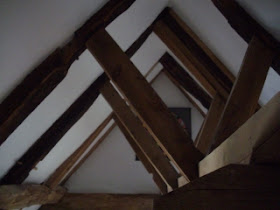On our journey north away from the spring of northern Italy we pause briefly to experience the same season just emerging in southern England. The buds here are swelling in the hedgerows, making this contrivance one of the most remarkable of man's creations. Some examples are nearly as ancient as human habitation; take a 30 metre length of hedge and its age in years can be roughly determined by multiplying the number of species by 110. Hawthorn and holly, beech and hazel, chestnut and alder plus so many more we cannot identify are all constrained together in a narrow corridor only an arm span wide which can stretch for many miles across the countryside. These are highways of life and they are as common here as they are absent from the land we have just left.
We stay for a few of days with friends, deep in Kentish farmland in their timber-framed cottage. From the back window we gaze out past the magnolia tree into a cherry orchard, home to magpies, woodpeckers, several tawny owls, the odd pheasant and many rabbits. A flock of rare-breed sheep, black with white faces (as if part of a photographic negative) are allowed to roam here in order to keep the grass trimmed and this gives a tidy aspect to the place, tidiness being a word that I have always felt applied to the countryside in this corner of Britain. In front gardens there is scarcely a hedge that is not trimmed, a lawn that is not cut or a shrub that is not pruned to within an inch of its life and this sense of order is somehow carried out into the farmland as well.
The land here appears almost flat (until you start walking when you soon realise it isn't) and the skyline is at eye level, decorated with trees, currently bare of leaves with their twisted branches exposed and cold. The English country cottage, black timbers intersecting white plaster, is what we think of when we use the phrase 'old house', just as in Italy it is a tall dwelling built of large, irregular stones, often plastered in yellow and connected in a cluster with others on a steep mountainside. The age of the dwelling in each country may well be similar but the view through the window can never be the same. In Italy the horizon is visible only by tilting the head back uncomfortably and raising the eyes heavenwards. The contrast between Kent and Ligurian Italy could not be more vivid.
Our friends' house, once three adjoining farm-workers cottages, is a now complex mix of dark beams and interesting corners, all tastefully decorated and with the conveniences of modern living blended neatly in. The positions of the walls between each of the former dwellings are still visible but these do not intrude or appear out of place. Wooden beams are 'original' which means that many have had a previous life somewhere else before being incorporated in the structure, perhaps in another house or maybe a ship. Look closely and you will find curious notches and grooves everywhere or a round hole with the remains of a wooden peg sticking out. Let the imagination wander and you'll see a mast standing here, a rope holding back a cannon or a hammock swinging.
These few days are a pause for for breath, a time for re-acclimatisation and relaxation in comfortable surroundings before we return to the Scotland we love so much.


No comments:
Post a Comment